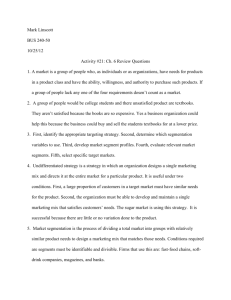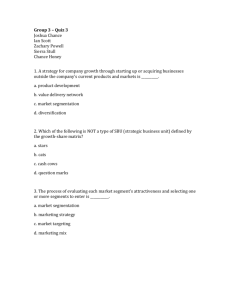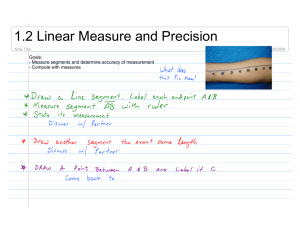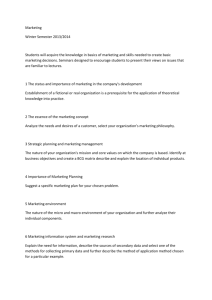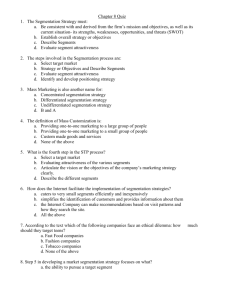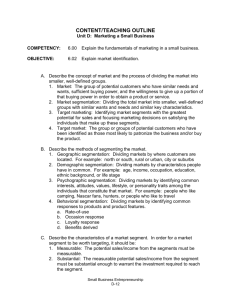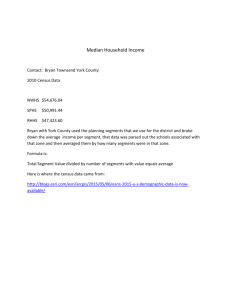Open Research Online Segmenting the energy market: problems
advertisement
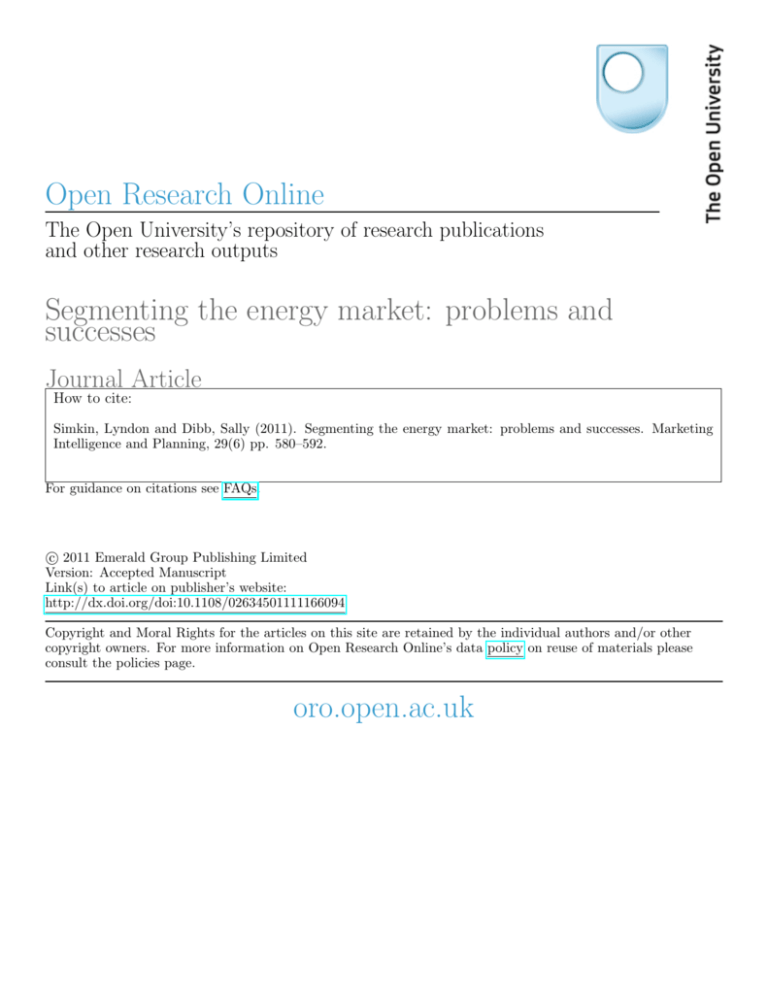
Open Research Online The Open University’s repository of research publications and other research outputs Segmenting the energy market: problems and successes Journal Article How to cite: Simkin, Lyndon and Dibb, Sally (2011). Segmenting the energy market: problems and successes. Marketing Intelligence and Planning, 29(6) pp. 580–592. For guidance on citations see FAQs. c 2011 Emerald Group Publishing Limited Version: Accepted Manuscript Link(s) to article on publisher’s website: http://dx.doi.org/doi:10.1108/02634501111166094 Copyright and Moral Rights for the articles on this site are retained by the individual authors and/or other copyright owners. For more information on Open Research Online’s data policy on reuse of materials please consult the policies page. oro.open.ac.uk Segmenting the Energy Market: Problems and Successes Introduction This case explores the use of market segmentation and the practical difficulties often encountered in such work. The solutions to these difficulties are highlighted. The case is based on the deregulated and highly competitive UK market for energy, namely gas and electricity supply. With little product differentiation possible, gas and electricity tend to be price-driven purchases, which increases the importance of effective segmentation and shrewd target segment selection. Both consumer and business segments are cited, with the case focusing more on the business-to-business outcomes for this energy provider. The approach adopted for selecting which segments to target is also featured. The case is appropriate for modules in marketing strategy, target marketing and marketing management, at MBA, MSc or advanced UG levels. Market Background When electricity supplies first spread throughout the UK they were provided by a plethora of local private companies, all using different specifications and power outputs, seeking to capitalise on the surge in demand for what was back then an ‘alternative’ energy. In order to maximise uptake, harmonise operating standards and also to ensure the public’s safety, government regulation eventually led to state-controlled regional monopolies and common distribution standards of operation. Following the introduction of such state control, for decades residents and commercial organisations in a particular locality were only able to purchase electricity from one local electricity supplier. Gas came from the Gas Board, later re-named British Gas. Other energy options such as oil, coal and LPG were open to localised competition, but not the distribution of mains gas and electricity. Commercial and household customers in a geographic region such as the Midlands or the South East had no choice but to receive both infrastructure and electricity from the region’s designated regional electricity company (REC). Price and service levels were fixed by regulation and the REC, with customers only able to buy from one supplier. During the 1980s, the UK Government privatised or deregulated nearly all remaining staterun enterprises, including the large airports (BAA), state airline (BA), logistics company (NFC/Excel), defence supply (BAe), car producers (Jaguar, Land Rover and Rover) and telecoms (BT). By the 1990s, it was the turn of the remaining utilities, including gas (British Gas/Transco), and the regional water and electricity companies. For the first time in living memory, consumers and business customers had a choice of electricity supplier or gas provider and could shop around. Natural gas was still centrally stored and distributed, but different operators could retail it, often targeting the same households and businesses with varying tariffs and levels of customer service. While various companies generated electricity, their power stations all fed the National Grid. These generating companies sold their electricity directly to businesses and consumers, but also to a diverse mix of other distributors, which were able to sell on this electricity under their own brands and tariffs to their mix of target markets. This newly deregulated market was attractive for other businesses to enter, with many wellknown brands such as Tesco, Virgin and Sainsbury’s deciding to retail the electricity generated by the major producers. The original RECs became acquisition targets, largely for larger energy businesses in France, Germany and the USA. A series of mergers and acquisitions over the next decade following privatisation and deregulation resulted in just six energy firms dominating the UK supply of electricity and gas: British Gas, French-based EDF Energy, Npower (owned by Germany’s RWE), Scottish and Southern, Scottish Power (owned by Spain’s Iberdrola) and Germany’s E.on after its purchase of PowerGen. The initial deregulated market was the business-to-business side of electricity and gas supply. Big commercial customers such as Corus (steel), Holiday Inn (hotels) or B&Q (retail) were quick to seek to reduce their considerable energy bills by switching to new lower-cost providers. Deregulation for the consumer household market followed a little later. Initially consumers were slow to switch and to appreciate the full implications from the Government’s de-regulation of the market. For some consumers, the changes were simply baffling. The comments in some focus groups from the time summed up their concerns: “If I switch supplier will a digger trash my garden by laying new cables to my house?” “Will the new company’s electricity be as good and as economical as the current stuff?” “I have never heard of the new supplier… will its electricity be as safe as mine is now?” In reality, it was the same electricity of similar quality/safety coming through the existing cables. Only the logo on the contract and bill changed, along with the price. Other consumers wanted more: “I will switch to whichever company only has green electricity!” However, the grid’s supply cannot discriminate between fossil fuel fired power stations and hydro-generation, let alone screen out electricity from nuclear stations! One major player spent much on a segmentation study of the residential market in the mistaken belief that so many consumers cared about customer service from their gas or electricity supplier that they would switch to the supplier providing the best customer service. In practice, some consumers expressed concerns about poor customer service, but way ahead in their hierarchy of needs was cheaper energy. Switchers of supplier nearly always were hooked by a better financial deal and cheaper energy bills. Now, well over a decade since deregulation, many consumers are enticed to switch electricity or gas supplier by the lure of lower prices or a guarantee of no price inflation for a fixed period. Many consumers have switched four or five times since deregulation, and the more promiscuous deal-conscious consumers may switch a few times each year. On the other hand, many consumers are still to switch once. The current recession has motivated increasing numbers of consumers to seek better deals, facilitated by on-line comparison web sites and media hype. The market has become increasingly price sensitive and few customers exhibit brand loyalty. The problem for suppliers is that electricity and gas are not the kinds of products which excite consumers or can readily be differentiated. Nevertheless, the maturity and competitive intensity of this market have encouraged companies to seek differentiation and to identify unique target market strategies. Brands Turn to Segmentation As competition intensifies in this price-led market, several of the larger energy suppliers have been trying to differentiate themselves on other dimensions than price; including their green credentials, tariff innovations and customer service capability. As often happens in maturing, competitive markets, these companies are also using more sophisticated market segmentation approaches in order to identify the most attractive groups of commercial and private customers to target. For example, E.on identified segments based on an account’s lifetime value, so as to ensure that the resources required to capture a new customer were recouped before the customer switched supplier again. One of the main providers of generating capacity, infrastructure and energy distribution opted to use a market segmentation approach in order to help energise its sales and key account managers, and to identify customers groups on which to focus its sales, marketing and customer support developments. This company’s leadership team included several MBA graduates who understood the benefits of market segmentation and two directors who were experienced in implementing the segmentation approach in other sectors. Collectively, they were confident in the deployment of market segmentation and well-placed to instigate its use. Although managers at this energy business understood the benefits which segmentation could bring and had the required knowledge of the techniques to carry it out, they recognised that there was likely to be resistance to the project. This would be for a variety of reasons, not least inertia and a dislike among staff of changing working remits. As a result of these concerns, the Strategy Director decided to encourage internal buy-in to the initiative by involving from the outset those senior and line managers most likely to be affected by the project outcomes: notably sales and key account management personnel. The Segmentation Project A rigorous process was adopted by this energy company that would stand up to external scrutiny and be compliant with regulations governing this sector. It was decreed that the resulting segments must be of sufficient size, markedly unique in their composition and characteristics, easy to populate by sales managers, prioritised in relation to their profitability and costs to serve, and firmly based around customer needs and buying behaviour. Project Aims The energy business wanted to: 1. Identify sub-groupings of customers based on a mix of characteristics, purchasing behaviour, lifetime account value and spend, rather than on profitability measures alone. 2. Generate enthusiasm and a sense of driving forward through this segmentation process amongst those managers engaging directly with customers. 3. Develop a segmentation solution readily transparent, so that staff would know instinctively in which segment a particular customer should be and how they should treat consumers in each segment. 4. Seek market leadership in an attractive set of market segments in a differentiated, competitively effective and regulatory compliant way. 5. Facilitate the development of marketing propositions tailored to targeted customer requirements, through novel and market-leading sales and marketing programmes. 6. Update its insights into customers, competitors, market trends and associated organisational capabilities. The first step in the project involved hosting an externally facilitated workshop for senior personnel and key line managers from sales, marketing, marketing research, key account management and customer service. This workshop established the requirements for the segmentation process in terms of resources, data, personnel, timeframes and reporting structures. A cross-functional sub-group of these executives became the core project team for the energy business, with a new marketing manager recruited to administer the segmentation project. The marketing manager and the project team were supported by a group of external experts, which typified this business’s approach Practitioners who conduct market segmentation have a plethora of approaches at their disposal. Many academic sources promote a quantitative survey-based approach, ignoring the company’s existing customer groupings and instead devising entirely new segments by conducting a ‘bottom-up’ analysis of customer attitudes, usage patterns, buying behaviour and characteristics. Under this approach, multivariate analysis is used to identify segments. Providing that internal structures and personnel can be readily realigned to fit the new segments, such an approach has much merit. In practice, organisations often struggle with this approach, particularly when it involves a radical redefinition of customer groups and targeting priorities. The macro-micro approach to segmentation was developed by business marketers in an attempt to overcome such difficulties and can be much easier to operationalise. This approach begins with the company’s existing customer groupings, using these and the knowledge associated with them as the basis for developing new segments. A critical review of the merits of different segmentation approaches is beyond the scope of this case study (see Dibb and Simkin, 2008 for more information about the various approaches). However, for this energy business, the macro-micro approach was preferred owing to cost and time pressures, but also because it was an appropriate vehicle for ensuring the direct participation of key personnel in creating the segments. The Segmentation Approach In line with best practice advice (cf: Dibb and Simkin, 2008; Simkin, 2008), a buying proforma was produced which captured the characteristics of customers, buying centre dynamics, energy usage and consumption data, customer needs and expectations, the buying decision-making process and influencing factors (cf: Appendix 1). This template was used to acquire these marketing insights for each of the company’s existing customer groupings. Over a three-week period, a series of workshops took place to examine each of these customer types, with the marketing manager acting as facilitator. Cross-functional teams were assembled on the basis of their expertise about particular customers; each comprised senior and line managers, sales, marketing, key account and customer service personnel. These teams found it difficult to generate a single buying proforma - set of customer insights for each existing customer group. In practice, each existing group was found to contain dissimilar customers, so it was not possible to generalise a group’s customers’ needs, characteristics, buying behaviour or influences. In other words, the existing customer groupings were characterised by higher than expected within-segment heterogeneity. These existing groups apparently had been devised over time to satisfy industry ‘norms’, operational convenience, regulatory compliance, and had emerged based on very rudimentary demographic classifications which bore no relation to consumers’ or business customers’ buying behaviour. Consequently, the workshops unravelled the existing customer groups, breaking each down into sub-groups of like-minded and similarly behaving consumers or business customers. One result was that there were far more numerous groups of customers identified. Typically between eight and twelve customer groups (each on a separate template) were identified from within each one of the initial customer groups! This reflects the scale of the problem encountered and the miss-match of dissimilar customers previously aggregated together into the company’s original markets. During subsequent meetings the project team was able to re-aggregate these numerous new sub-groups. It was found that many of the emerging buying proformas from originally separate markets in fact exhibited similar needs, buying centre dynamics, buying decisionmaking and influences (see Appendix A). In other words, many of the new sub-groups – from across different original markets/customer groups – could be aggregated together into homogeneous groups, or genuine market segments. By merging those templates which exhibited similar characteristics and behaviours, market segments were created. The Macro-Micro Segmentation Programme Project Team Assembled, Briefed and Project Scoped. Customer Analysis Brainstorming Sessions. Agreement on Targeting Criteria and for the Target Segment Strategy. Analyses of Financial Performance, Competitors, Market Trends, and the Forces of the Marketing Environment. Week 1 Weeks 2 - 6 Specification of Segment Marketing Plans, Marketing Programmes and Budgets. Prioritising and Profiling of Target Market Segments and Key Accounts. Final Target Market & Positioning Strategy Confirmatory Marketing Research to Validate the Brainstormed Segments. Weeks 6 - 10 Week 12 The Resulting Segmentation Solution Two segmentation schemes emerged: one for consumers (private households) and one for commercial customers (public and private sectors). The full details cannot be divulged here for reasons of corporate confidentiality, but there were ten consumer segments and fourteen business segments. A directional policy matrix assessment identified five consumer and six business segments to grow and several to harvest and hold. A decision was also taken to de- prioritise several other segments, for sales and marketing activities. For illustrative purposes, some of the disguised emerging business-to-business segments were: Segments included two in the public sector: The Professionals. Professional purchasing managers, focused on seeking value for the tax payer and good service levels, while becoming increasingly concerned about carbon footprint and green issues. Often with in-house energy specialists or advising consultants. No Change Traditionalists. More risk-averse public sector traditionalists, committee-led decision-making, very influenced by their own networks and by the activities of similar organisations. There were several commercial small business segments, including: Independents. Price-conscious owners of small enterprises, such as shops, business services or restaurants. Very much focused on reducing operating costs to support profitability and influenced by media views. Ego-Stroked Proprietors. Deal-seeking localised chains/SMEs, in which the entrepreneur’s ego must be ‘massaged’ and pampered. These owners need to be made to feel important. The Buyers. Energy-aware light manufacturing and small industrial firms, with energy managers and facilities managers (professionals), who want simplified buying and a good deal. Organisations operating across numerous sites fell into five segments, including: Energy Savvy. Large multi-site energy-aware businesses, such as retail chains, hotel groups and large manufacturers. Often with an in-house knowledgeable energy team, seeking significant cost savings and reliable multi-site billing. Low Awareness Purchasers. Multi-site customers requiring cost savings, like for the Energy Savvy segment, but not energy-savvy or really focused on energy trends. Site Churners. Multi-site operators with quickly changing site portfolios. Price is important, but not as much as service levels to help address frequent changes to the portfolio of properties operated. Frequent Switchers. Multi-site frequent switchers, fully deal-led and quick to change supplier, exhibiting no loyalty. The Targeting Strategy In parallel to identifying the market segments, the marketing team was updating its financial analyses, competitor intelligence and awareness of market trends, so that it had access to the required information for the targeting phase. The project team, in consultation with the senior leadership team, had decided to use a portfolio planning tool – the directional policy matrix – to guide this targeting phase of the project (cf: Appendix B). This involved agreeing a set of market attractiveness criteria which were weighted and used to rank emerging market segments in terms of their relative attractiveness and the company’s capability fit. Below is an indicative (disguised) version of the selected DPM variables and their relative weightings: Market Attractiveness Factors Variable Profitability of the Segment Lifetime Value of Customers in the Segment Propensity to Create a Brand Franchise Customers’ Ability to Pay/Risk of Debts Segment Growth Rate Segment Size Cost to Serve the Segment Customers’ Interest in Tech Applications Likelihood to Use Comparison Web Sites Predictability of the Energy Consumption Resources Required to Serve the Segment Propensity for Differentiation Business Strength Variables Weight 16 15 12 9 9 8 7 6 5 5 4 4 Variable Propensity for Aggressive Pricing Range of Products Applicable Track Record in the Segment Knowledge of the Buying Centre and Fit Trade Association/Partner Linkages Billing Capabilities Innovative/Flexible Pricing Multi-Site Relationship Management Sustainability Agenda CSR Policy for Low Income Users Weight 18 16 16 10 8 8 7 7 5 5 The market attractiveness-business strength model or directional policy matrix (DPM), originally created to examine product and brand portfolios, works very well in directing target segment selection (see Dibb and Simkin, 2008). The market attractiveness dimension includes all aspects that relate to the market, as deemed appropriate for a particular industry in judging the relative merits of segments. By using a set of variables (rather than a single financial indicator) the technique forces managers to consider attractiveness more broadly than in relation to only short-term profitability. The business strength/capability dimension is also a composite of factors, as detailed above. Such strengths or capabilities are internal issues unique to the organisation in question and its specific industry or commercial sector. Capabilities are generally benchmarked against the strongest and most successful competitor (Dibb and Simkin, 2010). The DPM grid portrays the attractiveness of segments, providing a numerical value for their relative attractiveness, as illustrated below. Prioritising Target Markets - Major Energy Player Disguised Example for the Identified Energy Market Segments High Each circle is one of the nine B2B segments listed in the case. Not all the segments resulting from the project are plotted here. This DPM is for illustration only. Market Attractiveness In practice, they were all plotted, for both the B2B and the B2C segmentations undertaken. This enabled the company to agree overall on which segments to focus its marketing programmes and resources. The circle size corresponded to the proportion of the company’s income from each market segment. Low High Business Strength Low Even though their awareness of many of the common problems associated with segmentation initiatives was high before commencing this segmentation project, the project team encountered a range of obstacles which hindered its progress. There were three types of problems: those arising prior to commencing the work, those occurring during the segmentation study, and those which emerged during the implementation of the new segments. Managing Problems Encountered Before, During and After the Segmentation Activity Any strategy initiative inevitably is never trouble-free. Rarely is a segmentation project without its impediments. Generally, there are problems before the project, during the creation of market segments and afterwards when implementing the resulting segmentation (see Dibb and Simkin, 2009, 2008 and 2001; Dibb, Simkin and Wilson, 2008). This project was no different. a) Infrastructure Impediments – Before Segmentation Previous experience of strategy and marketing initiatives ensured that this company appreciated the need for a cross-functional team, the importance of senior involvement, and the benefits of specialist support. As no suitable expert was available internally, an external segmentation consultant was recruited to support the project. Once the project was underway, the recruitment of a specialist marketing manager and other support personnel, helped mitigate another expected difficulty: that corporate pressures meant the solution had to be publicly available within three months of the project starting. This time pressure also steered the company towards the macro-micro buying proforma-led process. Although senior managers were generally receptive to the need to rethink the targeting strategy, it was also evident that some line managers were nervous about the changes that the new segmentation scheme might bring. A significant issue in advance of the segmentation work was the availability of topical, valid and pertinent data. While the company had much industry analysis, it had not undertaken wide-ranging, probing in-depth marketing analysis of customers. The decision to harness cross-functional teams in the series of workshops – including marketing, customer support, sales and key account management personnel, supplemented with external industry observers and pundits – helped to minimise the extent of this problem. The proforma-led macro-micro segmentation approach ensured that the necessary customer insights were collected. b) Process Issues – During Segmentation In the time available for the project, a large-scale quantitative survey of customers’ usage, attitude and purchasing behaviour was not feasible. Instead, managers began their analysis with the company’s current customer classification, electing to further disaggregate these groupings, before re-aggregating newly identified similar sub-groups to form more homogenous market segments. The advisers ensured a rigorous process was followed. This included instigating an in-depth review of the marketing environment and competitive forces, as well as calculating the internal financial value for different customer types. Data deficiencies had been anticipated from the onset of the project, but it quickly became clear that there were large gaps in information on customers’ buying behaviour, some aspects of the marketing environment, and details about competitors’ plans for different customer types. These deficiencies had to be swiftly rectified so as to avoid jeopardising the segmentation project. More workshops were staged to gain the views of customer-facing personnel, competitor analysis was stepped up, and validatory marketing research was commissioned in order to confirm the brainstormings of the company’s executives when tackling the buying proformas for each existing customer group. Two unexpected problems were that the segment profiling proved ineffective, while the company’s leadership team had problems populating the variables in the directional policy matrix without depending almost exclusively on short-term segment profitability as the measure of attractiveness. Several iterations were needed in order to develop robust segment profile descriptions which were understood and supported by all business functions. This involved many internal workshops and one-to-one meetings, putting pressure on the project’s pre-agreed timeline. A broader set of senior managers than expected was needed to specify the directional policy matrix variables and to determine the weightings to be used in evaluating segment attractiveness. The time-consuming nature of overcoming the impediments in data collection, segment description and targeting decisions reduced the time available to consider the roll-out of the resulting segments and to anticipate any problems. The project outcome became the presentation of the identified segments, rather than also including an associated set of marketing plans and a roadmap of marketing programme activities. c) Implementation Blockers – After the Segmentation The initial project planning, involvement of a senior cross-functional team, frequent workshops seeking colleagues’ insights but also enabling feedback regarding progress, and the visible support from directors, meant that the organisation was very well aware of the resulting segments before the implementation stage. There were five main problems faced in operationalising the segmentation scheme: Data mining. The company had to assign each of its millions of customers to one of the identified segments. This required specialist external assistance, a budget, energetic support from senior directors and many months. Once populated, the relative financial value of the segments could be calculated and performance standards established. Competitor intelligence. Although the competitive environment was already routinely analysed, the new segments meant that additional analysis was required, to allow an assessment of the extent to which a particular rival was addressing particular market segments. Corporate planning and business planning. As part of a large global business, corporate strategy and objectives were not static and did not ignore the involvement of the senior managers seeking to devote time and support to this segmentation project. There were some conflicts of interest, availability and commitment. Nit-picking. At each stage, senior sales managers argued about how the segments were to be defined and how the customers within them profiled. This was despite their active involvement in the workshops which had generated the segments. In order to address remaining concerns, further workshops and one-to-one sessions were required. Changing focus in programmes. Inevitably, changes were needed to the energy company’s sales and marketing programmes, to ensure that they fitted the new look customer segments and revised targeting priorities. It was some time before appropriate programmes were developed to address all of the prioritised segments, since some sales managers were reluctant to modify their practices and programmes. Summary There are many available options for undertaking segmentation. In this instance the expediency of the buying proforma-led macro-micro approach was preferred. Within three months, ten consumer segments and fourteen business segments had been identified for the gas and electricity markets. The energy company’s leadership team identified a set of market attractiveness and business capability variables in order to use the directional policy matrix to prioritise segments on which to focus sales and marketing resources. A robust set of operationally useful segments resulted, but it was some time before existing customers were profiled and assigned to these new segments. There was also a lag before appropriate marketing programmes and campaigns emerged, with which to pursue the most attractive segments. As with most strategy initiatives and segmentation projects, despite careful planning, the project was not without its problems. These were encountered prior to the start of the project, during the identification of the segments, and when operationalising the resulting segmentation solution. Most were dealt with expediently and successfully. References Dibb, S., and Simkin, L. (2010), “Target Segment Strategy”, in Marketing Theory, Baker, M. and Saren, M. (eds); London: Sage; chapter 11. Dibb, S. and Simkin, L. (2009), “Implementation rules to bridge the theory/practice divide in market segmentation”, Journal of Marketing Management, 25 (3/4), pp. 375-396. Dibb, S. and Simkin, L. (2008), Market Segmentation Success: Making it Happen!, New York: The Haworth Press. Simkin, L. (2008), “Achieving market segmentation from B2B sectorisation”, Journal of Business & Industrial Marketing 23, pp. 464-74. Dibb, S., Simkin, L. and Wilson, D. (2008), “Diagnosing and treating operational and implementation barriers in synoptic marketing planning”, Industrial Marketing Management, 37, pp. 539-553. Dibb, S., Simkin, L., Ferrell, O.C. and Pride, W. (2006), Marketing: Concepts and Strategies; Boston: Houghton Mifflin. Dibb, S. and Simkin, L. (2001), “Market segmentation: diagnosing and overcoming the segmentation barriers”, Industrial Marketing Management, 30, pp. 609-625. Other Useful Readings Beane T.P. and Ennis, D.M. (1987), ‘Market segmentation: a review’, European Journal of Marketing, 21 (October), pp. 20-42. Bonoma, T.V., Benson, I. and Shapiro, B.P. (1983), Segmenting Industrial Markets, New York: Lexington Books. Dibb, S. (1995), ‘Developing a decision tool for identifying operational and attractive segments’, Journal of Strategic Marketing, 3, pp. 189-203. Goller, S, Hogg, A. and Kalafatis, S. (2002), ‘A new research agenda for business segmentation’, European Journal of Marketing, 36 (1/2), pp. 252-271. Hlavacek, J.D. and Reddy, N.M. (1986), ‘Identifying and qualifying industrial market segments’, European Journal of Marketing, 20 (2), pp. 8-21. McDonald, M. and Dunbar, I. (2004), Market Segmentation, Basingstoke: Macmillan Press. Wedel, M. and Kamakura, W. A. (2002), Market Segmentation: Conceptual and Methodological Foundations, Boston: Kluwer. Weinstein, A. (2004), Handbook of Market Segmentation, New York: The Haworth Press. Wind, Y. (1978), ‘Issues and advances in segmentation research’, Journal of Marketing Research, 15 (August), pp. 317-337. Yankelovich, D. and Meer, D. (2006), “Rediscovering market segmentation”, Harvard Business Review, 84 (6), pp. 141-145. Questions For Discussion 1. How can organisations in mature, highly competitive markets use market segmentation to improve their performance and reappraise their marketing strategy? 2. To what extent was this energy business right to begin its segmentation exercise by analysing existing customer groups and how did the macro-micro approach help them to do so? 3. In what ways could the main problems encountered during the segmentation project and afterwards during the operationalisation phase have been predicted and pre-empted? How could these difficulties be remedied? Appendix A: The Buying Proforma The Macro-Micro Approach Utilising The Dibb/Simkin Buying Proforma © Sally Dibb & Lyndon Simkin Customer Profile & Energy Consumption Buying Process Influencing Factors 1. 2. Buying Centre Players 3. Key Customer Values (needs) 4. 5. 6. The above proforma captures the essential information about customers: their characteristics, who is involved (very important in B2B purchasing) and their key customer values/needs; along with the strategically essential insights into their decision-making and the all-important influences upon this buying process. Companies must reflect customers’ characteristics in their marketing programmes, but also who makes up the buying centre. The proposition has to deliver the desired KCVs, otherwise it will not entice these customers. Companies strive to become involved in their customers’ buying process at an earlier stage, and to manipulate as many of the influences as possible. The proforma should be completed from left to right. When using this template to help with deriving market segments, management teams list out their current markets or customer groups, irrespective of the bases for their original creation. They then strive to complete one of the above proformas for each customer group or type on their list. Typically, however, they will complete more than one proforma per each original customer group and not one. This is because dissimilar customers – in terms of their characteristics, buying centre composition, KCVs, decision-making and influences – have previously wrongly been allocated together. This debate tends to start in the left-hand column, with managers disagreeing about the characteristics to include on the proforma, customers’ needs and so forth. As a result, they identify several buying profiles from within each of the company’s existing customer groups (see Simkin (2008) for a more detailed illustration). Initially this sub-division causes alarm, as the original customer classification is broken down into far more numerous groups of customers. For example, one customer group containing dissimilar customers previously poorly aggregated together may be sub-divided into three, four or five buying proformas before any blurring is removed. Managers may then worry that they will have to deliver far more marketing programmes than prior to this analysis. However, it is then possible to identify several buying proformas – emerging from the analyses of previously different customer groups – which in practice share common characteristics, buying centre composition, needs, buying processes and influences. These ‘similar’ proformas may be aggregated to create homogeneous market segments. This is an example of macro-micro market segmentation: creating new market segments by commencing with an analysis of existing customer groups. Appendix B: The Directional Policy Matrix Market Attractiveness The Directional Policy Matrix [DPM] Market Attractiveness - Business Position Model Each circle represents a market segment High = High overall attractiveness Medium = Medium overall attractiveness = Low overall attractiveness Low Strong Medium Weak = The area of each circle represents the relative monetary sales on the matrix… the proportion of income from the segment Business Position/Strength Source: Dibb et al., 2006, p. 363. To create a DPM, managers (typically a company’s leadership team) should: • Select a set of variables with which to evaluate market attractiveness. Each manager should be asked to allocate 100 points between these attractiveness variables, giving more points to the variables deemed highly important. These managers’ views should then be aggregated in order to find a weighting for each variable (as in the example in the case). These weightings should total to 100. • Select a set of variables with which to evaluate business strength. Each manager should be asked to allocate 100 points between these business strength variables, giving more points to the variables deemed highly important. These managers’ views should then be aggregated in order to find a weighting for each variable (as in the example in the case). These weightings should total to 100. • Each segment should then be assessed using these two sets of variables and their respective weightings. For a particular segment, a variable deemed good/high should be scored 1.0, or if so-so 0.5, or if poor/low 0. The weighting is multiplied by the score for each variable in the two lists for each segment. • These values are than totalled for market attractiveness and separately for business strength, for each segment analysed. Each segment will then have a total value between 0 and 100 for market attractiveness and also for business strength, enabling it to be plotted on the DPM. The DPM’s axes run from 0 to 100. • Segments plotted upper left on the DPM should be supported, as they are attractive and the company’s business strengths or capabilities are a good fit. Unless acting as a barrier to competitors or when all development costs and capital expenditure have been previously paid back, any segments plotted lower right on the DPM should not be pursued. See Dibb et al. (2006) or Dibb and Simkin (2008) for worked examples and a more extensive explanation.


